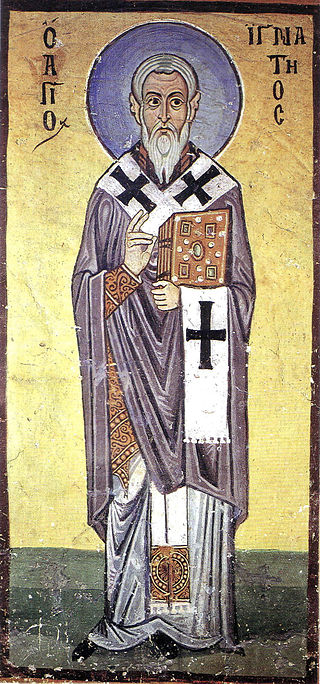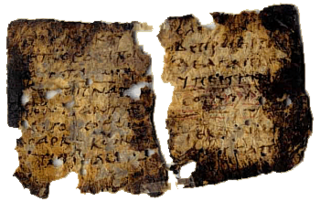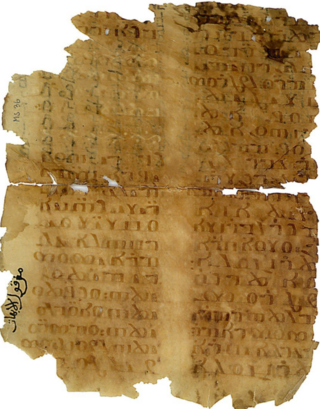
The Epistle of James is a general epistle and one of the 21 epistles in the New Testament. It was written originally in Koine Greek.

The First Epistle to the Corinthians is one of the Pauline epistles, part of the New Testament of the Christian Bible. The epistle is attributed to Paul the Apostle and a co-author, Sosthenes, and is addressed to the Christian church in Corinth. Despite the name, it is not believed to be the first such letter. Scholars believe that Sosthenes was the amanuensis who wrote down the text of the letter at Paul's direction. It addresses various issues that had arisen in the Christian community at Corinth and is composed in a form of Koine Greek.

Ignatius of Antioch, also known as Ignatius Theophorus, was an early Christian writer and Patriarch of Antioch. While en route to Rome, where he met his martyrdom, Ignatius wrote a series of letters. This correspondence forms a central part of a later collection of works by the Apostolic Fathers. He is considered one of the three most important of these, together with Clement of Rome and Polycarp. His letters also serve as an example of early Christian theology, and address important topics including ecclesiology, the sacraments, and the role of bishops.
The New Testament (NT) is the second division of the Christian biblical canon. It discusses the teachings and person of Jesus, as well as events relating to first-century Christianity. The New Testament's background, the first division of the Christian Bible, is called the Old Testament, which is based primarily upon the Hebrew Bible; together they are regarded as Sacred Scripture by Christians.

The Codex Vaticanus, designated by siglum B or 03, δ 1, is a Christian manuscript of a Greek Bible, containing the majority of the Greek Old Testament and the majority of the Greek New Testament. It is one of the four great uncial codices. Along with Codex Alexandrinus and Codex Sinaiticus, it is one of the earliest and most complete manuscripts of the Bible. Using the study of comparative writing styles (palaeography), it has been dated to the 4th century.

The Epistle of Barnabas is a Greek epistle written between AD 70 and 132. The complete text is preserved in the 4th-century Codex Sinaiticus, where it appears at the end of the New Testament, following the Book of Revelation and before the Shepherd of Hermas. For several centuries it was one of the "antilegomena" ("disputed") writings that some Christians looked on as sacred scripture, while others excluded them. Eusebius of Caesarea classified it with excluded texts. It is mentioned in a perhaps third-century list in the sixth-century Codex Claromontanus and in the later Stichometry of Nicephorus appended to the ninth-century Chronography of Nikephoros I of Constantinople. Some early Fathers of the Church ascribed it to the Barnabas who is mentioned in the Acts of the Apostles, but it is now generally attributed to an otherwise unknown early Christian teacher, although some scholars do defend the traditional attribution. It is distinct from the Gospel of Barnabas.

The Didache, also known as The Lord's Teaching Through the Twelve Apostles to the Nations, is a brief anonymous early Christian treatise written in Koine Greek, dated by modern scholars to the first or second century AD.

Philotheos Bryennios was a Greek Orthodox metropolitan of Nicomedia, and the discoverer in 1873 of an important manuscript with copies of early Church documents.
The Apostolic Fathers, also known as the Ante-Nicene Fathers, were core Christian theologians among the Church Fathers who lived in the 1st and 2nd centuries AD who are believed to have personally known some of the Twelve Apostles or to have been significantly influenced by them. Their writings, though widely circulated in early Christianity, were not included in the canon of the New Testament. Many of the writings derive from the same time period and geographical location as other works of early Christian literature which came to be part of the New Testament.

The New Testament apocrypha are a number of writings by early Christians that give accounts of Jesus and his teachings, the nature of God, or the teachings of his apostles and of their lives. Some of these writings were cited as scripture by early Christians, but since the fifth century a widespread consensus has emerged limiting the New Testament to the 27 books of the modern canon. Roman Catholic, Eastern Orthodox, and Protestant churches generally do not view the New Testament apocrypha as part of the Bible.

The Codex Alexandrinus, designated by the siglum A or 02, δ 4, is a manuscript of the Greek Bible, written on parchment. Using the study of comparative writing styles (palaeography), it has been dated to the fifth century. It contains the majority of the Greek Old Testament and the Greek New Testament. It is one of the four Great uncial codices. Along with Codex Sinaiticus and Vaticanus, it is one of the earliest and most complete manuscripts of the Bible.
The Apostolic Constitutions or Constitutions of the Holy Apostles is a Christian collection divided into eight books which is classified among the Church Orders, a genre of early Christian literature, that offered authoritative pseudo-apostolic prescriptions on moral conduct, liturgy and Church organization. The work can be dated from 375 to 380 AD. The provenance is usually regarded as Syria, probably Antioch. The author is unknown, although since James Ussher it has often considered to be the author of the letters of Pseudo-Ignatius, perhaps the 4th-century Eunomian bishop Julian of Cilicia.

The First Epistle of Clement is a letter addressed to the Christians in the city of Corinth. The work is attributed to Clement I, the fourth bishop of Rome and almost certainly written by him. Based on internal evidence some scholars say the letter was composed some time before AD 70, but the common time given for the epistle's composition is at the end of the reign of Domitian. It ranks with Didache as one of the earliest, if not the earliest, of extant Christian documents outside the traditional New Testament canon. As the name suggests, a Second Epistle of Clement is known, but this is a later work by a different author. Part of the Apostolic Fathers collection, 1 and 2 Clement are not part of the canonical New Testament.
A biblical manuscript is any handwritten copy of a portion of the text of the Bible. Biblical manuscripts vary in size from tiny scrolls containing individual verses of the Jewish scriptures to huge polyglot codices containing both the Hebrew Bible (Tanakh) and the New Testament, as well as extracanonical works.

Christian Palestinian Aramaic was a Western Aramaic dialect used by the Melkite Christian community, probably of Jewish descent, in Palestine, Transjordan and Sinai between the fifth and thirteenth centuries. It is preserved in inscriptions, manuscripts and amulets. All the medieval Western Aramaic dialects are defined by religious community. CPA is closely related to its counterparts, Jewish Palestinian Aramaic (JPA) and Samaritan Aramaic (SA). CPA shows a specific vocabulary that is often not paralleled in the adjacent Western Aramaic dialects.
The Codex Athous Laurae, designated by Ψ or 044, or δ 6, is a manuscript of the New Testament written in Greek uncial letters on parchment. The manuscript has many gaps in the text, as well as containing handwritten notes. Using the study of comparative writing styles (palaeographically), the codex is dated to the 8th or 9th century.

Papyrus 6, designated by 𝔓6 or by ε 021, is a fragmentary early copy of the New Testament in Greek and Coptic (Akhmimic). It is a papyrus manuscript of the Gospel of John that has been dated paleographically to the 4th century. The manuscript also contains text of the First Epistle of Clement, which is treated as a canonical book of the New Testament by the Coptic Church. The major part of the codex is lost.

Minuscule 1739, α 78, is a Greek minuscule manuscript of the New Testament, on 102 parchment leaves. It is dated paleographically to the 10th century.
The Taktikon Uspensky or Uspenskij is the conventional name of a mid-9th century Greek list of the civil, military and ecclesiastical offices of the Byzantine Empire and their precedence at the imperial court. Nicolas Oikonomides has dated it to 842/843, making it the first of a series of such documents extant from the 9th and 10th centuries. The document is named after the Russian Byzantinist Fyodor Uspensky, who discovered it in the late 19th century in a 12th/13th-century manuscript in the library of the Eastern Orthodox Patriarchate of Jerusalem, which also contained a portion of the Kletorologion of Philotheos, a later taktikon.
Codex Sinaiticus Rescriptus, mostly originating in Saint Catherine's Monastery, Sinai from Sin. Georg. 34; Tsagareli 81, is an accumulation of nineteen Christian Palestinian Aramaic palimpsest manuscripts containing Old Testament, Gospel and Epistles pericopes of diverse Lectionaries, among them two witnesses of the Old Jerusalem Lectionary, various unidentified homilies and two by John Chrysostom, hagiographic texts as the Life of Pachomios, the Martyrdom of Philemon Martyrs, and the Catecheses by Cyril of Jerusalem. The palimpsests manuscripts are recycled parchment material that were erased and reused by the tenth century Georgian scribe Ioane-Zosime for overwriting them with homilies and a Iadgari. Part of the parchment leaves had been brought by him from the Monastery of Saint Sabas, south of Jerusalem in the Kidron Valley, when he moved to St Catherine's Monastery and became there librarian. In the nineteenth century most of the codex was removed from the monastery at two periods. C. Tischendorf took two thirds in 1855 and 1857 with the Codex Sinaiticus to St Peterburg and handed it over to the Imperial Library, now the National Library of Russia, and the remaining third left on a clandestine route [so-called collection of Dr Friedrich Grote (1862-1922)] and found its way into various European and later also into US collections, at present in a Norwegian collection. From the New Finds of 1975 in the Monastery of Saint Catherine missing folios of some of the underlying manuscripts could be retrieved, with one connected to Princeton, Garrett MS 24.











